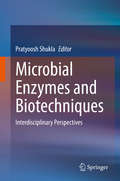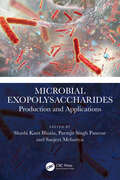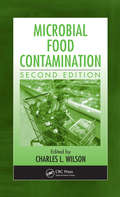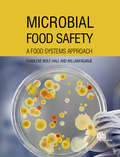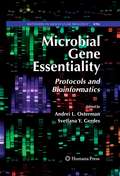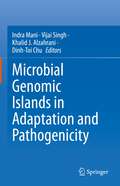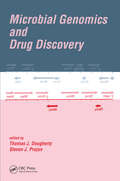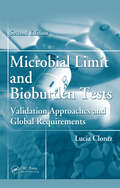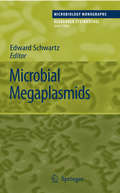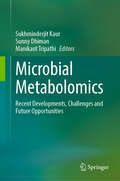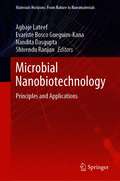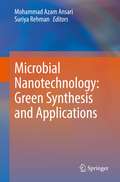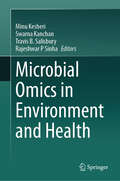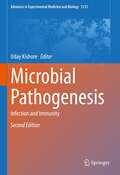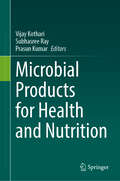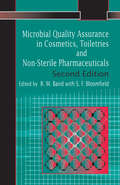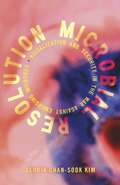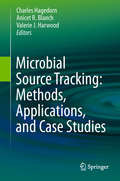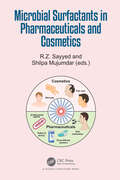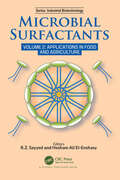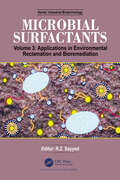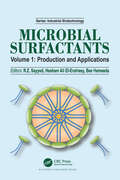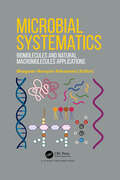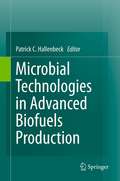- Table View
- List View
Microbial Enzymes and Biotechniques: Interdisciplinary Perspectives
by Pratyoosh ShuklaThis book compiles the latest research on the multifarious roles of microbial enzymes, and provides an overview of microbial enzymes and biotechnologies. It discusses the use of microbial enzymes in innovative areas like nanomedicine and synthetic biotechnology, as well as the use of starch digesting enzymes and bioactive proteins as biotherapeutics, all of which have applications in modern drug discovery processes. The book also examines the concept of microbial biotransformation and protein engineering, and covers topics such as the immobilization of therapeutic enzymes, bioengineering of enzymes for bioactive compounds, the production of hydrolytic and oxidative enzymes from plant raw materials, and prebiotics and probiotics.Given its multidisciplinary scope, this book will appeal to researchers and industry experts in the fields of microbiology, biotechnology and molecular medicine.
Microbial Exopolysaccharides: Production and Applications
by Shashi Kant Bhatia Parmjit Singh Panesar Sanjeet MehariyaThis book offers a complete coverage of microbial refinery for exopolysaccharides (EPS) production, including genetic improvements, production techniques, biotechnological applications in food, cosmetics, health and environment sector, economic perspectives, and commercialization of EPS products. It focuses on exopolysaccharides production from an organism perspective to offer a complete picture from isolation of microbes to commercialization of EPS-based products. It covers strategies for EPS production and future perspectives and the potential of microbial refinery.Features: Provides a concise introduction to the science, biology, technology, and application of exopolysaccharides (EPS) Details upstream and downstream steps in EPS production from microbial resources Acts as a complete guide from production to commercialization Explores the potential application of EPS for socioeconomical benefits Discusses the EPS applications in food, cosmetics, health, and bioremediation approach for clean and sustainable development This book is aimed at researchers and graduate students in fermentation technology, biochemical engineering, and biotechnology.
Microbial Fermentation and Enzyme Technology
by Hrudayanath Thatoi Pradeep K. Das Mohapatra Sonali Mohapatra Keshab C. MondalThe discovery of enzymes as biocatalysts has led to various biotechnological developments. The capability of enzymes to catalyse various chemical reactions both in vivo and in vitro has led them to applications in various industries, such as food, feed, pharmaceutical, diagnostics, detergent, textile, paper, leather, and fine chemical industries. Microbial Fermentation and Enzyme Technology mainly focuses on production and application of enzymes in various industries. Further, it also discusses recent developments in enzyme engineering particularly those involved in creating and improving product formations through enzyme and fermentation technology. Salient features: Includes current research and developments in the area of microbial aspects in different fields like food, chemicals, pharmaceutical, bioprocess, etc. Discusses various enzymes that are used in refinement of environmental pollutions and its application in different industrial sectors Focuses on production and application of enzymes in various industries Highlights recent developments in enzyme engineering with respect to its application in textile, pharmaceutical, nanobiotechnology, bioremediation and many other related fields.
Microbial Food Contamination
by Charles L. WilsonDivided into five parts, Microbial Food Contamination, Second Edition looks at emerging foodborne human pathogens andcomprehensively evaluates the microbiology, biochemistry, detection, risk, and threat of foodborne illness in today's global market. The first section introduces new insights into the pathogenic effect of E. coli, viral
Microbial Food Safety
by Charlene Wolf-Hall Andwilliam NganjeThis interdisciplinary textbook provides the reader with vital information and comprehensive coverage of foodborne microbial pathogens of potential risk to human consumers. It includes human pathogens and toxins originating from plants, fungi and animal products and considers their origin, risk, prevention and control. From the perspectives of microorganisms and humans, the authors incorporate concepts from the social and economic sciences as well as microbiology, providing synergies to learn about complex food systems as a whole, and each stage that can present an opportunity to reduce risk of microbial contamination. Microbial Food Safety: A Food Systems Approach explains concepts through a food supply network model to show the interactions between how humans move food through the global food system and the impacts on microorganisms and risk levels of microbial food safety. Presented in full colour throughout, this book: - Is clearly organised into easy digestible and accessible contents - Includes key questions, summaries, further reading and a glossary to aid and focus reading - Contains information boxes and numerous examples to help you review and apply the concepts covered Written by authors renowned in the field and with extensive teaching experience, this book is essential reading for upper-level undergraduate and postgraduate students of food microbiology, food safety and food science, in addition to professionals working in these areas.
Microbial Gene Essentiality: Protocols and Bioinformatics
by Svetlana Y. Gerdes Andrei L. OstermanThis book contains a comprehensive collection of experimental and computational strategies and techniques for microbial genome-scale essentiality studies, developed and presented by the leading groups in the field. It contains detailed description of the procedures, discussion of potential difficulties and failures. All protocols follow the successful Methods in Molecular BiologyTM series format.
Microbial Genomic Islands in Adaptation and Pathogenicity
by Vijai Singh Indra Mani Khalid J. Alzahrani Dinh-Toi ChuThis book elucidates the role of microbial genomic islands (GEIs) in genome stability, plasticity, evolutionary adaptation, and pathogenicity in the bacterial population. The initial chapters of the book present tools, including bioinformatics, artificial intelligence, machine learning, next-generation sequencing, and molecular biology techniques, for the analysis of the genomic islands. The book also discusses the importance of genomic islands in bacterial speciation, acquisition of genes related to resistome, nitrogen fixation, mobilomes, and nutritional fitness and adaptation. It provides recent advances in understanding microbial genomic islands' distribution, evolution, and mechanistic modes of behavior in pathogenic, non-pathogenic, and environmental species. This book is a valuable source for beginners in molecular microbiology, students, researchers, clinicians, stakeholders, and policymakers interested in understanding the role of GEIs in the adaptive evolution of microorganisms.
Microbial Genomics and Drug Discovery
by Thomas J. Dougherty Steven J. ProjanExploring innovative routes of drug discovery in the postgenomic era, Microbial Genomics and Drug Discovery examines bioinformatic and genomic approaches for the identification, detection, selection, and validation of new antibacterial targets and vaccine candidates. The book discusses potential pathways for effective infection control, inhibition of antibacterial resistance, and acceleration of the drug discovery process. This comprehensive reference describes procedures to recognize common targets in various bacterial species for the design of broad-spectrum antibiotics and clearly illustrates the use of pathway tools in a genomics-based drug discovery project.
Microbial Limit and Bioburden Tests: Validation Approaches and Global Requirements,Second Edition
by Lucia ClontzIn recent years, the field of pharmaceutical microbiology has experienced numerous technological advances, accompanied by the publication of new and harmonized compendial methods. It is therefore imperative for those who are responsible for monitoring the microbial quality of pharmaceutical/biopharmaceutical products to keep abreast of the latest c
Microbial Megaplasmids
by Edward SchwartzMegaplasmids are extrachromosomal genetic elements in the size range of 100 kb and larger. They are found in physiologically and phylogenetically diverse groups of bacteria and archaea. By definition, megaplasmids are not essential for the viability of their hosts under all growth conditions, but paradoxically many megaplasmids carry the genetic information for the defining and characteristic traits of the organism in which they reside. Microbial Megaplasmids reviews our knowledge of the extensively studied representatives, such as the catabolic plasmids of the pseudomonads, the rhizobial Sym plasmids, the Ti plasmids of the genus Agrobacterium and the giant enterobacterial virulence plasmids. It also presents snapshots of more recently discovered megaplasmids. The contribution of megaplasmids to the biology of their hosts is described, highlighting the interactions between megaplasmid and chromosomal genes.
Microbial Metabolomics: Recent Developments, Challenges and Future Opportunities
by Sunny Dhiman Sukhminderjit Kaur Manikant TripathiThis book explores the potential of microbial metabolism in health, agriculture, and environmental technologies, serving as a comprehensive guide to microbial metabolomics with practical applications. It uncovers the complex biochemical processes of microbes, from bacteria to fungi, revealing their impact on biotechnology, environmental sciences, healthcare, and agriculture. Microbes, the unseen drivers of biological processes, offer innovative solutions across these fields. The book examines the rapid advancements in microbial metabolomics and addresses challenges like data integration and metabolite identification, providing insights to unlock its full potential. It caters to the growing demand for advanced resources in microbiology and biotechnology, making it valuable for researchers, students, and professionals in microbiology, biotechnology, and biochemistry, as well as innovators in food security and green technology.
Microbial Nanobiotechnology: Principles and Applications (Materials Horizons: From Nature to Nanomaterials)
by Shivendu Ranjan Nandita Dasgupta Agbaje Lateef Evariste Bosco Gueguim-KanaThis edited book serves as a vital resource on the contributions of microorganisms to advances in nanotechnology, establishing their applications in diverse areas of biomedicine, environment, biocatalysis, food and nutrition, and renewable energy. It documents the impacts of microorganisms in nanotechnology leading to further developments in microbial nanobiotechnology. This book appeals to researchers and scholars of microbiology, biochemistry and nanotechnology.
Microbial Nanotechnology: Green Synthesis and Applications
by Mohammad Azam Ansari Suriya RehmanThis book introduces the principles and mechanisms of the biological synthesis of nanoparticles from microorganisms, including bacteria, fungi, viruses, algae, and protozoans. It presents optimization processes for synthesis of microbes-mediated nanoparticles. The book also reviews the industrial and agricultural applications of microbially-synthesized nanoparticles. It also presents the medical applications of green nanoparticles, such as treating multidrug-resistant pathogens and cancer treatment. Further, it examines the advantages and prospects for the synthesis of nanoparticles by microorganisms. Lastly, it also presents the utilization of microbial-synthesized nanoparticles in the bioremediation of heavy metals.
Microbial Omics in Environment and Health
by Rajeshwar P. Sinha Minu Kesheri Swarna Kanchan Travis B. SalisburyThis book describes the basic concepts and recent advances in new discoveries and technologies related to microbial omics and their role in environmental research and human health. The term "omics" refers to a blend of high-throughput analysis and traditional methods including genomics, transcriptomics, proteomics, lipidomics and metabolomics for a variety of applications in the field of life sciences, biomedical sciences, environmental sciences, and related industries. The book aims to fill the existing gap in terms of a comprehensive approach that incorporates recent advances in this dynamic field and provides an answer to why this field requires an interdisciplinary research approach. The focus of this book is on the applications of genomics, epigenomics, metagenomics, integrative omics, machine learning and microbiome research in environmental health, disease, wastewater epidemiology, antibiotic resistance, drug discovery, cancer, production of secondary metabolites of microbial origin, oxidative stress alleviating mechanisms, etc. The overall construction of this book emphasizes three major perspectives, namely, elaborate knowledge from fundamentals to recent advances in technologies about omics in general and its application in microbiology, environment, and health in particular; illustrative figures capable of easy visualization of complex pathways; and serving as a platform for highly demanded bioinformatics strategies including relevant codes, programming scripts, machine learning and use of artificial intelligence strategies needed to streamline the research outcomes. With global contributions from authors from internationally renowned organizations who excel in relevant research, this book will benefit bibliophiles and prospective audiences from the research fraternity, academia, professionals, and experts in the field of life sciences, biomedical as well as industries related to the development of drug design and novel advances in biotechnological applications.
Microbial Pathogenesis: Infection and Immunity (Advances in Experimental Medicine and Biology #1313)
by Uday KishoreThis book updates in detail the microbial pathogenesis of various important pathogens, including HIV-1, MERS, SARS-CoV-2, Mycobacterium and Plasmodium. There is also a general discussion of the innate and adaptive immune responses against primary and opportunistic infections. The overall purpose of the book is to aid in the development of anti-viral and anti-microbial targets.
Microbial Products for Health and Nutrition
by Prasun Kumar Vijay Kothari Subhasree RayThis book highlights microbial products and their applications in the health sector. The chapters introduce novel advancements and applications in different pharmaceutical and nutraceutical aspects of applied microbiology. Readers will obtain a detailed overview of the relevance of microbial metabolites to human health and nutrition. Besides knowing the products already developed, they will also get an idea of microbial products currently in the development pipeline and those that are likely to emerge as potential nutraceuticals. Readers will get an interesting and useful perspective on how supplementing food with microbes or their bioactive metabolites can realize the idea of 'food as medicine'. This book introduces the biological activities of various microbial fermentation products, and how they are relevant to mitigating various disease conditions (e.g. neuropathy, diabetes, gut dysbiosis, malnutrition, etc.) in humans. One of the highlights of this volume is the exploration of microbial pigments as potential substitutes for synthetic colorants, offering safer and more sustainable alternatives for the food and healthcare industries. The book has equivalent contributions from experts in academia and industry to fill the communication gap between them. Through this book, readers will gain valuable insights into the historical perspectives, contemporary impacts, and future prospects of microbial applications in health and nutrition. From food preservation to biopharmaceutical production, the potential of microbial products to revolutionize our approach to health and wellness is undeniable.
Microbial Quality Assurance in Pharmaceuticals, Cosmetics, and Toiletries (Taylor And Francis Series In Pharmaceutical Sciences Ser.)
by R. Baird Sally F. BloomfieldThe importance of quality assurance in the production, storage and use of manufactured preparations is widely recognized. This book encapsulates the issues involved in the manufacture of non-steriles, such as creams, ointments, herbal remedies, shampoos, soaps and toiletry products (as opposed to sterile drugs and injectible products). Knowledge of the microbial limits is expanded, new standards are included, and coverage of the preservation issues of dosage forms is widened to include semi-solids and liquid preparations. This edition also contains new regulations regarding preservative efficacy testing and covers pharmacopoeial and industry regulations and guidelines. Rapid methods are also discussed, now more common in cosmetic and toiletry practice, in their pharmaceutical capacity.
Microbial Resolution: Visualization and Security in the War against Emerging Microbes (Proximities)
by Gloria Chan-Sook KimAn interdisciplinary study charting the war against microbial futures leads to a new theory of contemporary vision and visuality In 1989, a group of U.S. government scientists met to discuss some surprising findings: new diseases were appearing around the world, and viruses that they thought long vanquished were resurfacing. Their appearance heralded a future perpetually threatened by unforeseeable biological risks, sparking a new concept of disease: the &“emerging microbe.&” With the Cold War nearing its end, American scientists and security experts turned to confront this new &“enemy,&” redirecting national security against its risky horizons. In order to be fought, emerging microbes first needed to be made perceptible; but how could something immaterial, unknowable, and ever mutating be coaxed into visibility, knowability, and operability? Microbial Resolution charts the U.S.-led war on the emerging microbe to show how their uncertain futures were transformed into objects of global science and security. Moving beyond familiar accounts that link scientific knowledge production to optical practices of visualizing the invisible, Gloria Chan-Sook Kim develops a theory of &“microbial resolution&” to analyze the complex problematic that arises when dealing with these entities: what can be seen when there is nothing to see? Through a syncretic analysis of data mining, animal-tracking technologies, media networks, computer-modeled futures, and global ecologies and infrastructures, she shows how a visual impasse—the impossibility of seeing microbial futures—forms the basis for new modes of perceiving, knowing, and governing in the present. Timely and thought provoking, Microbial Resolution opens up the rich paradoxes, irreconcilabilities, and failures inherent in this project and demonstrates how these tensions profoundly animate twenty-first-century epistemologies, aesthetics, affects, and ecologies.
Microbial Source Tracking: Methods, Applications, and Case Studies
by Valerie J. Harwood Anicet R. Blanch Charles HagedornUnderstanding the origin of fecal pollution is essential in assessing potential health risks as well as for determining the actions necessary to remediate the quality of waters contaminated by fecal matter. As a result, microbial source tracking (MST) has emerged as a field that has evolved and diversified rapidly since the first approaches were described only a decade ago. In response to the emergence of MST, there have been three large multi-laboratory method comparison studies (two in the US and one in Europe), plus numerous workshops, book chapters, and review articles dedicated to synthesizing information on the topic. Furthermore, a federal (USEPA) guide document describing the uses and limitations of MST methods was published in 2005, and a book dedicated to MST as an emerging issue in food safety was published in 2007. These documents provide a collective body of literature on MST that is both conflicting and complementary, often repetitious, and difficult to condense and interpret. In addition, it does not reflect the current diversity of MST approaches with different organisms, newer methodologies such as quantitative PCR, and anthropogenic chemicals, nor does it embrace the scope of MST research being conducted around the world. The three editors of the book, all with extensive MST expertise, have developed chapters and invited authors who reflect the rich diversity and truly international scope of MST. The unifying theme throughout the book is the design of more standardized approaches to MST that include performance criteria (regardless of method or organism), plus recommendations for field study design and MST implementation. The editors intend that this book will serve as a valuable reference for all those who are involved with
Microbial Surfactants in Pharmaceuticals and Cosmetics
by R. Z. Sayyed Shilpa MujumdarBiosurfactants and bioemulsifiers are considered green molecules as they are produced from microbes and are easily degradable as compared to surfactants. They are suitable due to properties such as low toxicity, tolerance to a wide-range pH level and temperature, high surface activity, biodegradability, excellent emulsifying and demulsifying ability. While, caution and care should be exercised in its widespread usage, they are likely to replace chemical surfactants.The book focuses on biosurfactant production from various bacteria, diversity of biosurfactant producing bacteria, and the industrial need of biosurfactants. Fields such as pharmacy, medicine, and cosmetics are covered. It is presented in an easy-to-understand manner, and is well illustrated, and comprises protocols and recent data on the production, formulation and commercialization and other aspects of biosurfactants and bioemulsifiers.
Microbial Surfactants: Volume 2: Applications in Food and Agriculture (Industrial Biotechnology)
by R. Z. SayyedBiosurfactants are surface-active biomolecules produced by a wide variety of microorganisms. They can be produced from renewable sources, and possess high surface activity, high specificity, low toxicity, tolerance to pH, temperature and ionic strength, biodegradability, excellent emulsifying and demulsifying ability and antimicrobial activity. Biosurfactants have found applications in several industries including organic chemicals, petrochemicals, mining, metallurgy (mainly bioleaching), agrochemicals, fertilizers, foods, beverages, cosmetics, pharmaceuticals and many others. The main aim of this volume is to highlight concepts, classifications, production and applications of microbial surfactants in food and agriculture. The book provides a comprehensive coverage of fermentation, recovery, genomics and metagenomics of biosurfactant production. It is presented in an easy-to-understand manner, and includes protocols, figures, and recent data on the industrial demand market and economics, and the production of biosurfactants from novel substrates are particularly worthwhile additions. The volume will be useful for students, researchers, teachers, and entrepreneurs in the area of microbial biosurfactants and their applications in food and agriculture.
Microbial Surfactants: Volume 3: Applications in Environmental Reclamation and Bioremediation (Industrial Biotechnology)
by R. Z. SayyedBiosurfactants are the surface-active biomolecules produced by a wide range of microorganisms. The enormous diversity of biosurfactants make them an interesting group of molecules. Biosurfactants, are less toxic, eco-friendly and possess amphiphatic structure. Due to these and many other useful properties, biosurfactants play a significant role in oil recovery, waste utilization and bioremediation of industrial effluents; hydrocarbons, pesticides and toxic heavy metals and many other hazardous substances. Biosurfactants offer numerous advantages over chemical surfactants. They are environmentally friendly, can be produced from natural sources, less toxic, possess high specificity, have better foaming and emulsifying properties and survive extreme conditions such as high temperatures, extreme pH and salinity. They are cheaper as they can be produced from industrial waste and from by-products as opposed to chemical surfactants. This volume comprises concepts, classification, production and applications of biosurfactants in oil recovery, environment and clean up, etc. It is an excellent literature on fermentation, recovery, genomics and metagenomics of biosurfactant production. It is presented in an easy-to-understand manner, with well-illustrated diagrams, protocols, figures, and recent data on the production, formulation and commercialization and other aspects of biosurfactants. As such, the book will be useful for students, researchers, teachers, and entrepreneurs in the area of PGPR and its allied fields.
Microbial Surfactants: Volume I: Production and Applications (Industrial Biotechnology)
by Hesham All El-EnshasyBiosurfactants are the surface-active biomolecules produced by microorganisms. Biosurfactants have gained commercial significance due to their unique properties, such as high surface activity, high specificity, low toxicity, tolerance to pH, temperature and ionic strength, biodegradability, excellent emulsifying and demulsifying ability, antimicrobial activity, ability to work under extreme conditions, and relative ease of preparation. Biosurfactants are used in several industries, including organic chemicals, petroleum, petrochemicals, mining, metallurgy (mainly bioleaching), agrochemicals, fertilizers, foods, beverages, cosmetics, pharmaceuticals and many others. The aim of this book is to highlight key aspects from basics to advanced concepts, classifications, production and applications in various fields such as agriculture, health, bioremediation, industries, pharmaceutical, oil recovery, environment, and nanotechnology. It also serves as an excellent and expansive literature on fermentation, recovery, genomics, and metagenomics of biosurfactant production. The book focuses on the biosurfactant production from bacteria, the diversity of biosurfactant producing bacteria, and industrial need of biosurfactant.
Microbial Systematics: Biomolecules and Natural Macromolecules Applications
by Bhagwan Narayan RekadwadMicrobial species isolated from extreme and pristine habitats are always diverse, which indicates biomolecules secreted by these species might have importance. A cure for disease is a desire considering the catastrophic situations that threaten the lives of humans and animals. Currently, the world is facing the health, social and economic, and diplomatic impacts of infectious communicable diseases caused by bacteria and viruses. It is a necessity to understand the huge microbial diversity residing everywhere with us in this world. Microorganisms are species that were born at the start of “life” and will stay after the end of all other forms of life in this world. This unseen majority has significant effects on the biogeochemical cycle as well as has numerous medical and non-medical applications. So, the ability of microorganisms to produce bioactive compounds and how they can be used in different fields, especially medicine and health care, have been discussed in this book.
Microbial Technologies in Advanced Biofuels Production
by Patrick C. HallenbeckConcerns over dwindling fossil fuel reserves and impending climate changes have focused attention worldwide on the need to discover alternative, sustainable energy sources and fuels. Biofuels, already produced on a massive industrial scale, are seen as one answer to these problems. However, very real concerns over the effects of biofuel production on food supplies, with some of ht recent increases in worldwide food costs attributable to biofuel production, have lead to the realization that new, non-food substrates for biofuel production must be bought online. This book is an authoritative, comprehensive, up-to-date review of the various options under development for the production of advanced biofuels as alternative energy sources. A general overview and introductory chapters for each section place the field in the context as well as provide essential basic notions for the more general reader. Accomplished, internationally recognized experts carrying out research on individual focus areas contribute specific technical chapters detailing present progress and future prospects.
